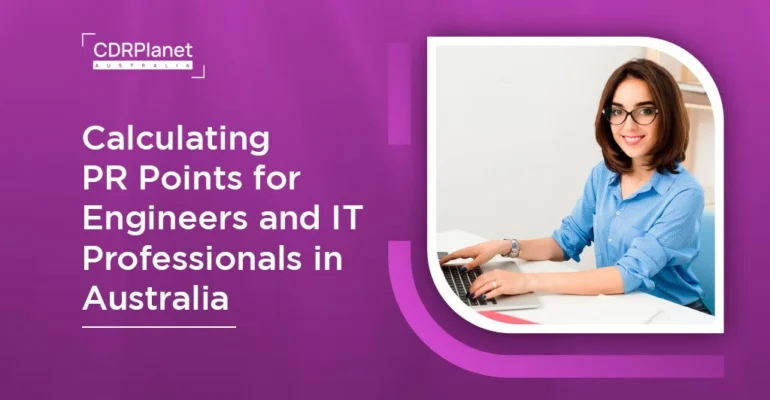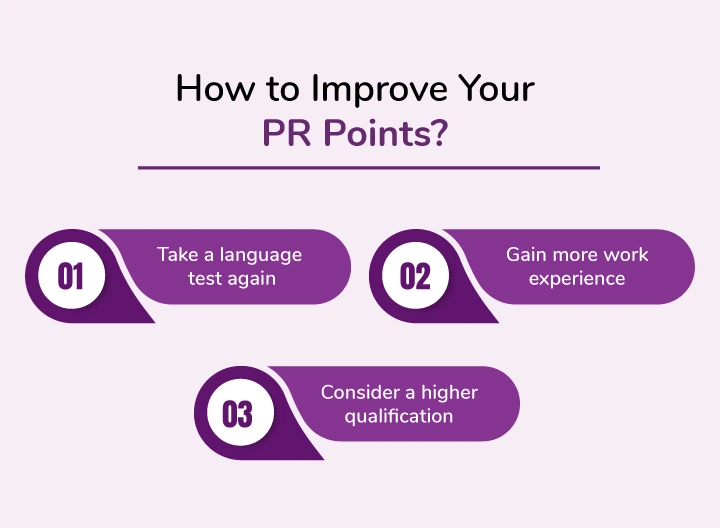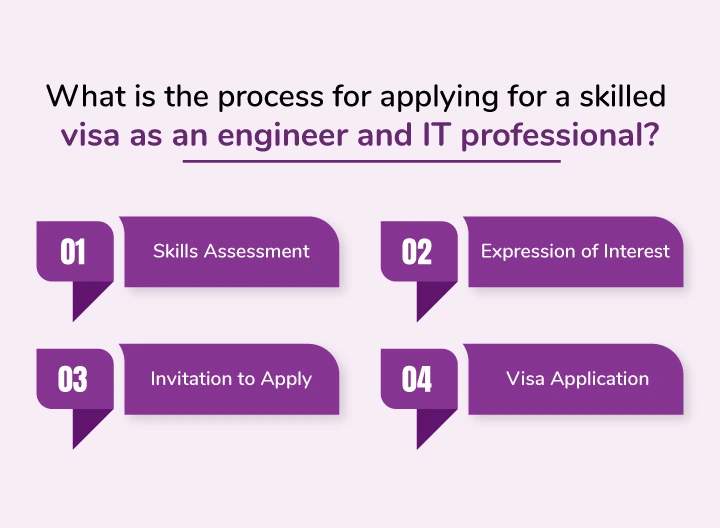Calculating PR Points for Engineers and IT Professionals in Australia

Calculating PR Points for Engineers and IT Professionals in Australia
Want to secure your Australian PR points as a skilled professional? Here’s How to Maximise Your Points! Becoming a permanent resident (PR) in Australia is a goal for many experienced professionals.
The Australian PR points system takes into account a variety of important factors, such as your age, English skills, work experience, and qualifications, creating a comprehensive picture of your journey.
In this guide, we will help engineers and IT professionals understand the key components of the PR points system. We will also provide an overview of how the CDR report and ACS RPL play a vital role in securing PR in Australia.
How does the Australian Department of Home Affairs determine PR points?
The Australian Department of Home Affairs uses a points-based system to assess applicants. Your points are calculated based on factors like age, English skills, and work experience.
Each factor contributes a certain number of points, with younger applicants and those with higher English proficiency scoring more. Your total points play an important role in determining your eligibility for a skilled visa.
Generally, you’ll want to aim for at least 65 points to qualify for permanent residency. But remember, the more points you accumulate, the better your chances are of receiving that exciting invitation to apply!
A Comprehensive Guide to Understanding Australia’s PR Points System

This guide will provide you with a roadmap to calculate points effectively. Plan your migration journey strategically for a successful application.
A) Introduction to Australia’s PR Points System
Australia’s immigration system relies heavily on the PR points-based method, designed to select skilled workers who will contribute to the Australian economy.
The system is fair and transparent, allowing skilled workers from all over the world to apply for permanent residency.
The number of PR points that engineers and IT professionals derive for PR depends on age, English proficiency, work experience, education, etc.
B) Key Factors That Affect Your PR Points Calculation
Multiple factors play a role in calculating your PR points for the Australian immigration process.
- Age
The younger folks have the exciting opportunity to earn even more points! If you are younger, you will have more opportunities to earn.
- English Proficiency
Strong English language skills are highly valued. Higher scores in English tests like IELTS or PTE can give you significant points.
- Work Experience
The number of years you’ve worked as an engineer, both in Australia and abroad, will also add to your points total.
- Educational Qualifications
A higher level of education, particularly a qualification related to your occupation, increases your points.
- Other Factors
Partner skills, regional study, and state nomination can provide additional points.
C) Additional Factors That Impact Points
Apart from age, English proficiency, work experience, and qualifications, there are other ways to gain additional PR points for engineers and IT professionals.
Partner Skills
If your spouse or partner has skills that are in demand in Australia, you can receive additional PR points. This could be another way to improve your score.
| Partner Skill Level | Points |
| Partner with skills | 5 |
| No partner skills | 0 |
Study in Australia
If you’ve studied in Australia, especially in a regional area, you could earn additional PR points. Obtaining a qualification in a charming regional area can earn you an extra 5 PR points, helping you on your journey.
| Study in Regional Australia | PR Points |
| Completed qualification | 5 |
| No regional study | 0 |
State Nomination
If you happen to be nominated by one of our wonderful Australian states or territories, you could gain an extra 5 points! This is especially beneficial for skilled workers in occupations that are in demand in specific regions.
| State Nomination | PR Points |
| Yes | 5 |
| No | 0 |
D) Example of Points Calculation for an Engineer
Let’s walk through an example calculation for an engineer to better understand how this works. Suppose you are 30 years old, have a bachelor’s degree in civil engineering, score proficient in English, and have 5 years of work experience.
| Factor | PR Points |
| Age (25-32 years) | 30 |
| English (Proficient) | 20 |
| Work Experience (5-7 years) | 10 |
| Educational Qualifications (Bachelor’s Degree) | 15 |
| Total Points | 75 |
In this example, the engineer earns a total of 75 points, which is above the minimum threshold of 65 points. This would make them eligible to apply for a skilled visa, assuming they meet other requirements.
How to Improve Your PR Points?

If you find that your point total is below the required 65, there are several ways you can work on improving your chances:
A) Take a language test again
Achieving a higher score on your English test can make a big difference in your PR application. For example, moving from a proficient level to a superior level can add extra points to your score.
B) Gain more work experience
If you’re short on PR points, gaining an extra year or two of work experience in your field can boost your PR points by 10, 15, or even 20. This additional experience strengthens your application.
C) Consider a higher qualification
Obtaining a master’s degree or a doctoral degree can boost your PR points in the points system.
This advanced education boosts your qualifications and makes you more competitive in the immigration process.
Applying for PR as an Engineer or IT Professionals
Once you have calculated your PR points for engineers and IT professionals and verified your eligibility, the next step is to apply for a skilled visa.
A skilled visa allows engineers to live and work in Australia based on their qualifications and experience. It is designed for professionals whose skills are in demand in the country.
There are different types of skilled visas, such as the skilled independent visa (subclass 189) and the skilled nominated visa (subclass 190). Each visa has specific eligibility requirements.
What is the process to apply for a skilled visa as an engineer and IT professional?

a) Skills Assessment
- Skill Assessment for Engineers
Engineers applying for a skilled visa must have their qualifications assessed by a relevant authority, like Engineers Australia. This process ensures that their education and work experience meet Australian standards.
The assessment involves submitting documents like your degree, work history, and a Competency Demonstration Report (CDR). Once your application gets the green light, you’ll be all set to move forward with your visa application!
- Skill Assessment for IT Professionals
IT professionals need to undergo a skills assessment by the Australian Computer Society (ACS). This assessment shows that your impressive qualifications and valuable work experience are a great fit for what Australia needs.
You’ll need to submit your educational qualifications, work history, and sometimes a detailed report of your projects. After that, if the interview is over, you can proceed with your visa application for PR points.
If you have more than 8 years of experience in the IT field but no formal qualifications, you can still migrate to Australia as a skilled worker. To do so, you must demonstrate your skills and experience through the RPL process.
The ACS RPL allows you to showcase your practical experience and how it meets the Australian industry’s standards. By submitting detailed reports of your work history and competencies, you can prove your skills.
b) Expression of Interest (EOI)
You can easily submit your Expression of Interest (EOI) using the SkillSelect system, a friendly online platform supported by the Australian government. This step showcases your eligibility and interest in migrating to Australia.
When completing the EOI, you will be required to give details of your skills, qualifications, proficiency in English, and points test. It acts as a pre-application to show you’re qualified for a skilled visa.
Submitting a strong EOI improves your chances of getting an invitation. Higher points, based on age, English skills, and experience, make your application more competitive.
c) Invitation to Apply
If your EOI meets the required points and occupation demand, you may receive an invitation to apply for a skilled visa. Invitations are sent based on your ranking and the visa quota.
This is a formal step where the government recognises you as a potential candidate for migration. Receiving an invitation is a key milestone in the process.
The invitation allows you to move forward with the final visa application. Make sure to act quickly, as invitations usually have strict deadlines for submission.
d) Visa Application
Once you receive our warm invitation, you’ll be all set to apply for your skilled visa, like the skilled independent visa. You’ve made it to the final step of this journey!
You’ll need to submit supporting documents, including proof of qualifications, English test results, and work experience. Ensure everything is accurate and complete.
Once your application is approved, you will be granted a visa to live and work in Australia as a permanent resident. This brings exciting new possibilities and a wonderful chance for a fresh beginning in Australia.
Conclusion
Calculating your PR points for engineers and IT professionals may feel complicated, but it becomes easier once you understand the system. Breaking down each factor helps simplify the process and guide you through the steps.
Success lies in focusing on key areas like improving your English skills, gaining work experience, and selecting the right education. Each of these factors adds valuable points to your total.
With planning and dedication, technical professionals can navigate the PR points system effectively. This approach helps you move one step closer to making Australia your new home.
If you have any further questions or need personalised advice, feel free to reach out to a migration agent or visit the official Department of Home Affairs website for more information.
FAQs
1. What is the new points system for Australia 2024?
Australia’s 2024 points system prioritises younger, skilled workers with strong English and regional qualifications. It emphasises employability and partner contributions, streamlining pathways to permanent residency.
2. Which engineering is best for PR in Australia?
Civil, mechanical, and electrical engineering are top fields for PR in Australia due to high demand and inclusion on the Skilled Occupation List (SOL).
3. Is the 189 visa for skilled workers?
Yes, the 189 visa is for skilled workers who want to live and work in Australia permanently. Eligible applicants must meet skill and qualification requirements.
4. Is 75 points enough for an 189 visa?
A 75-point score for an 189 visa can be competitive, but it depends on occupation demand and invitation thresholds. Higher points improve chances, especially for in-demand fields. Check invitation rounds regularly for updates.
5. Do I need a skill assessment for visa 189?
Yes, a skill assessment is required. It verifies that your qualifications and work experience match the occupation listed on Australia’s Skilled Occupation List. The assessment must be done by an assessing authority.
6. Can a work visa be converted to PR in Australia?
Yes, a work visa can be converted to PR in Australia. After meeting the required criteria, such as work experience and skills assessment, you can apply for PR. Check eligibility requirements for different PR pathways based on your visa type.
7. How can a skilled worker immigrate to Australia?
A skilled worker can immigrate to Australia by applying for a points-based visa, like the 189 or 190. The process includes a skills assessment and an invitation to apply.
8. Is the 190 visa for skilled workers?
Yes, a 190 visa is for skilled workers who have been sponsored by an Australian state or territory.
9. What is the difference between the 189 visa and the 190 visa in Australia?
The 189 visa is a skilled independent visa that doesn’t require state sponsorship, while the 190 visa is state-nominated. The 190 visa gives you an extra 5 points for nomination but requires you to live and work in the nominating state.